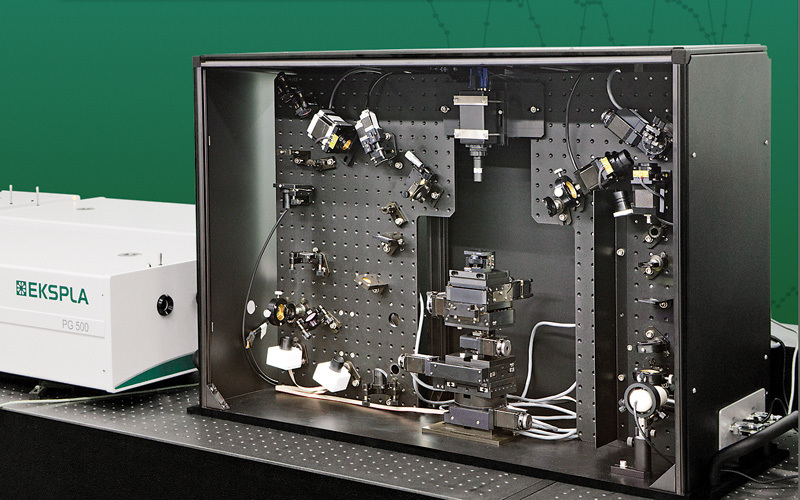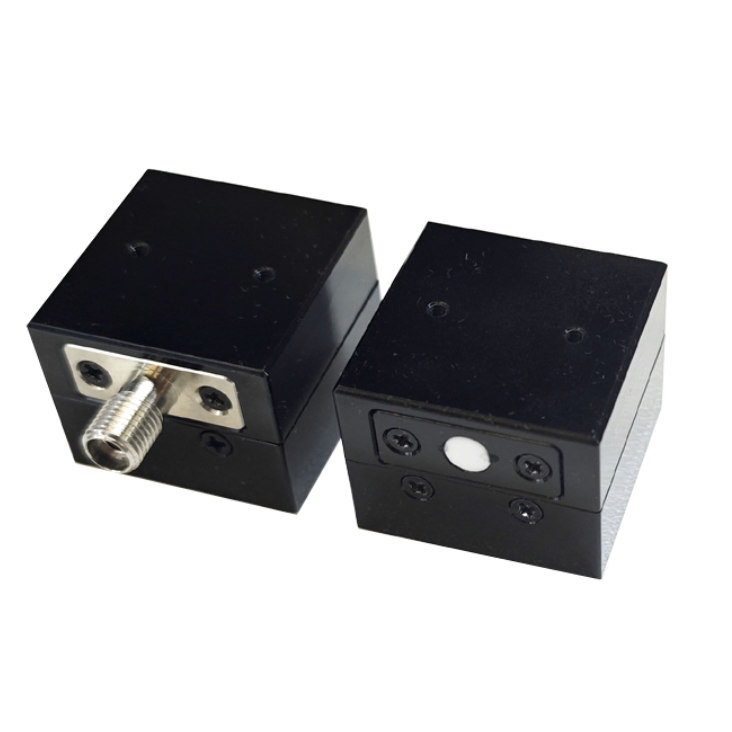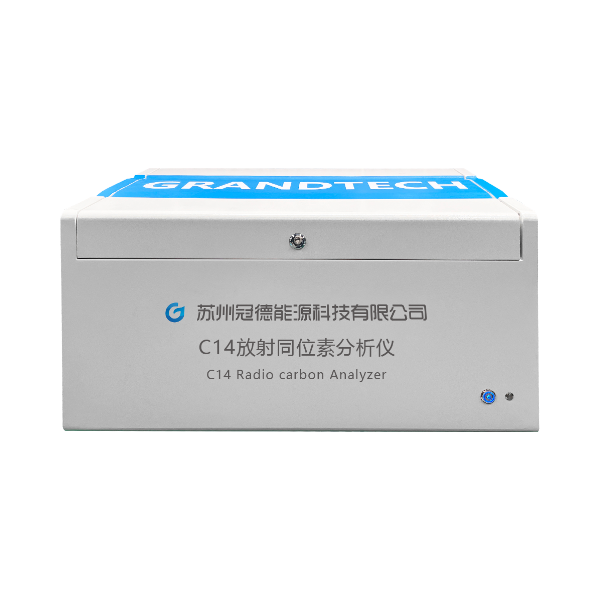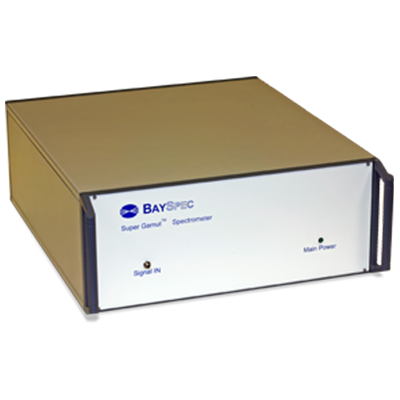Stability of the Si-H bonds on the hydrogen-terminated Si(111) surface has been investigated by sum frequency generation (SFG) spectroscopy in air at room temperature. The SFG observation showed that the Si(111) surface is terminated by a monolayer of monohydride (Si-H) after etching in a concertrated ammonium fluoride (NH4F) solution. The number of Si-H bonds decreased with laser irradiation time and the abstraction rate of hydrogen atoms on Si increased with the increase of input energy of "visible" light. The Si-H bond under irradiation at 1064nm light was more stable than that at 532nm light with a given intensity. A small amount of water in air severely lowered the stability of Si-H bond because of a photoelectrochemical recation under laser irradiation.
方案详情

SURFACE SCIENCESurface Science 476 (2001) 121-128www.elsevier.nl/locate/susc 122S. Ye et al. / Surface Science 476 (2001)121-128 0039-6028/01/$- see front matter @ 2001 Elsevier Science B.V. All rights reserved.PII: S0039-6028(01)00690-2 Stability of the Si-H bond on the hydrogen-terminatedSi(111) surface studied by sum frequency generation Shen Ye , Toshiya Saito , Satoshi Nihonyanagi, Kohei Uosaki a,*,bPaulo B. Miranda ,Doseok Kim , Yuen-Ron Shenb,1 aPhysical Chemistry Laboratory, Division of Chemistry, Graduate School of Science, Hokkaido University, Sapporo 060-0810, Japan°Department of Physics, University of California, Berkeley, CA 94720, USA Received 30 August 2000; accepted for publication 25 December 2000 Abstract Stability of the Si-H bonds on the hydrogen-terminated Si(111) surface has been investigated by sum frequencygeneration (SFG) spectroscopy in air at room temperature. The SFG observation showed that the Si(111) surface isterminated by a monolayer of monohydride (Si-H) after etching in a concentrated ammonium fluoride (NH4F) so-lution. The number of Si-H bonds decreased with laser irradiation time and the abstraction rate of hydrogen atoms onSi increased with the increase of input energy of “visible”light. The Si-H bond under irradiation at 1064 nm light wasmore stable than that at 532 nm light with a given intensity. A small amount of water in air severely lowered the stabilityof Si-H bond because of a photoelectrochemical reaction under laser irradiation. @ 2001 Elsevier Science B.V. Allrights reserved. Keywords: Sum frequency generation; Desorption induced by photon stimulation; Photochemistry; Silicon; Low index single crystalsurfaces; Hydrogen atom; Solid-gas interfaces 1. Introduction Affurther understanding of the nature ofbonding and electronic properties of hydrogentermination on Si surfaces is important for bothfundamental research and industrial applications.It has been shown that a chemical etching processusing a concentrated ammonium fluoride (NH4F)solution in an atmospheric environment can give a ( C orresponding author. T e l.: + 81-11-706-3812; fax: +81-11- 706-3440. ) ( E-mail a ddress: uosaki@pcl.sci.hokudai.ac.jp(K. Uosaki) Also corresponding author. ) H-passivated atomically flat Si(111) surface [1,2].As suggested by the result of attenuated totalreflection infrared (ATR-IR))spectroscopy, theSi(111) surface with a (1×1) structure is termi-nated by an extremely homogeneous monolayer ofhydrogen [1,2]. This ideally hydrogen-terminatedSi(111) surface has become a model system forstudying mechanisms of heterogeneous chemicalreactions on Si surfaces in ultrahighvacuum(UHV),in atmosphere and in electrolyte solution[3-51. The characteristics of such a H-terminated (H-)Si(111) surface have also been studied by infra-red-visible sum frequency generation (SFG). As ahighly surface-specific technique, SFG has been proved to be one of the most powerful and ver-satile method for studies of interfacial chemicalphenomena [6-9]. Guyot-Sionnest et al. first em-ployed the time-resolved SFG technique to inves-tigate the lifetime of the Si-H stretching vibrationon H-Si(111) surface in UHV [10]. Subsequently,many studies on relaxation dynamics of Si-Hstretching vibration on ideal and vicinal Si(111)[10-13]and Si(100) [14] surfaces have been carriedout. Most of these SFG measurements were per-formed in UHV environment. However for manyapplications, we are interested in the characteris-tics of Si surfaces in real environment. In partic-ular, it is important to know the stability of thesurface Si-H bonds in various environments. Al-though the stability of the Si-H bonds under laserirradiation in UHV has been studied extensively[15-17], the same is not true in real atmosphere.Very different surface stabilities are expected forSi-H bonds in vacuum and in ordinary atmo-sphere beca1uuse of the existence of oxygen, waterand other reaction species in the later environ-ment. In this paper, we report the use of SFGvibrational spectroscopy to investigate the stabilityof the Si-H bonds on the hydrogen-terminatedSi(111) surface in ordinary atmosphere at roomtemperature. We studied the effects of laser pump-ing at two different laser frequencies, one stronglyand the other weakly absorbed by the Si sub-strate. 2. Experimental An Nd:YAG laser system (model PL2143Bfrom EKSPLA Co.) generating ~25 ps pulses at arepetition rate of 10 Hz was used in the SFG ex-periment. The output had three different frequen-cies, 1064, 532 and 355 nm. The 355 nm outputwas used to pump an optical parametric genera-tion and amplification (OPG/OPA) system. Theoutput from the OPG/OPA was mixed with the1064 nm laser output in a nonlinear crystal,Ag2GaS2, to generate a tunable infrared outputfrom 2.3 to 8.5 um by the difference frequencygeneration (DFG) process. The linewidth of the tunable infrared output was ~6 cm- determinedby the double-grating setup in the OPA path. The“visible”output from the laser and tunableinfrared output from the DFG were incident andoverlapped at the sample surface with incidenceangles of 70° and 50°, respectively. Either the 532or 1064 nm laser output was used as the “visible”light in the SFG measurement. The beam spotof the “visible”and infrared lights had an ellipti-cal shape with a dimension of ≈2.5×0.9 and0.3×0.2 mm², respectively.2The SFG signal wascollected through a monochromator (ORIEL MS-257) by a photomultiplier (Hamamatsu IR630-10) that covered a wavelength range from 185 to930 nm and a gated electronic system. When the532 nm“visible" light was used, a holographicSuperNotch filter (HSPF-532-1.0, Kaiser OpticalSystem, Inc.) was placed in front of the mono-chromator to further reduce scattered visible light.All SFG spectra were obtained by averaging 50 pulses per data point and were normalized againstthe infrared and“visible”inputs. The SFG spectraof H-Si stretching vibration on the H-Si(111)surface were fitted using the following equation[6-91: where ω is the infrared frequency, xe is the nonresonant contribution to the surface nonlinearsusceptibility, and wo, Ao and To are the resonantfrequency, strength and damping constant of theSi-H stretching vibration, respectively. The n-type Si(111) wafers (phosphor-dopedwith p=3-5Qcm) donated by Shin-Etsu Semi-conductors were used as samples. The chemicaletching procedure used to prepare the H-Si(111)surface was the same as that reported previously[2]. The Si wafers were first cleaned in a sonication ( S pot sizes were de t ermined as follows. Iri s was placed at the position o f the sample, the position of the i ris was changed by micrometer ( r esolution 0.01 m m) and li g ht passed th e iris wasdetected. Although we have determined the sizes of 532 nm and IR lights but not of the 1 064 n m l i ght, w e think the size of 532 nm and that of 1064 nm w e re not too m u ch different. The focal l ens for “ visible”lights was made o f B K 7 wi t h th e focal l e ngth of 600 mm. ) bath of acetone and then with Milli-Q water(resistivity > 18 MQcm). The Si samples were thenoxidized in a boiling solution of concentratedHC1:H202:H2O (1:1:4) for 20 min,etched in 40%NH4F solution (Morita Chemical Industries, ELgrade) for 5 min, rinsed by Milli-Q water, and fi-nally dried in flowing purified nitrogen gas. The SFG measurements were carried out in anair conditioned room, where the typical roomtemperature and relative humidity were 22°C and40%, respectively. 3. Results and discussion Fig. 1 shows an SFG spectrum of H-Si(111)with the polarization combination of SFG, “visi-ble” and infrared beams as p,p and p, respectively(black circles, Fig. 1). The frequency of the infra-red light was scanned from 2060 to 2110 cm-while wavelength of“visible”light was kept con-stant at 532 nm. Input energies of the visible andinfrared lights were 16 and 25 pJ/pulse, respec-tively. A strong SFG peak was observed at 2085cm- and was assigned to the resonant SFG bandof the monohydride Si-H stretching vibrationon the H-Si(111) surface as reported previously[1,2,10]. The SFG spectrum was fitted with Eq. (1) Wavenumber/cm-1 Fig. 1. SFG spectrum of H-Si stretching vibration from theH-Si(111) surface obtained by using 532 nm visible (16 pJ/pulse) and tunable infrared (25 pJ/pulse) input beams. Thepolarization combination of SFG,visible and infrared is(p,p,p). The solid line is the theoretical fit. (solid line, Fig.1). The results showed that theSFG band contains only one component. The fullwidth at half maxima (FWHM) of the band was~7cm-1, which was broader than that obtained byprevious ATR-IR measurement (~1 cm-l)[1,2]because of the larger linewidth (>6 cm-) of thetunable infrared output from the OPG/OPA sys-tem. No peaks attributable to dihydride (SiH2)and trihydride (SiH) were observed in the SFGspectrum. The SFG observation confirmed anatomically flat H-Si(111) surface was obtained bythe chemical etching procedures. Fig. 2a shows the time sequence of a set of SFGspectra of the Si-H stretching vibration from theH-Si(111) surface under constant pulsed 532 nm(8 pJ/pulse) and tunable infrared excitation (30 pJ/pulse) in air. Each spectrum was obtained in ap-proximately 5 min. It is seen that spectral peakintensity does not change appreciably for the first60 min but decreases rapidly afterwards. Thenormalized peak strength, Ao, obtained by fittingthe spectra with Eq. (1) (solid lines, Fig. 2a) isplotted as a function of the laser irradiation time(Fig. 2b). It was found that Ao decreased to ap-proximately 15% of its original value after a 2.5 hirradiation. Since the number of Si-H bonds at thesurface (0n) is proportional to Ao, thiss result indicates that the On decreases toapproximately 15% of its original value after a2.5 h irradiation. A recent ATR-FTIR study onH-Si(111) showed that the IR absorption band ofthe Si-H stretching vibration hardly changed after5 h of exposure in dry air [2], indicating that Si-His stable as far as the sample is left in air. Thus, thedecay of the spectral peak in Fig. 2 must be in-duced by the laser irradiation of 532 nm andinfrared. That the irradiation effect becomes ap-preciable only after ~60 min suggests that it mayhave undergone first nucleation and then growthstages. Hydrogen on Si(111) is relatively stable ona fully hydrogen-terminated Si(111) surface. Ab-straction of H by other species at the H-Si(111)surface will increase significantly when the ab-stracted H sites show up on the surface. Wavenumber/cm (b) Fig. 2. (a) Time sequence of a set of SFG spectra of H-Sistretching vibration from the H-Si(111) surface under 532 nm(8uJ/pulse) and tunable infrared (30 pJ/pulse) irradiation. Thesolid curves are fits using Eq. (1). (b) Mode strength Ao ob-tained from the fits plotted as a function of irradiation time. In order to investigate the decay process of thehydrogen coverage on Si(111) more quantita-tively, we measured SFG versus time with infraredfrequency fixed at the peak position (2085 cm-).Fig. 3 shows the result in logarithmic scale fordifferent input laser energies at 532 nm, keepingthe infrared input energy constant at 25 pJ/pulse.If the visible input energy is lower than 17 pJ/pulse, the decrease of SFG intensity is very slow and is only 10% after 60 min. This is in agreementwith the result presented in Fig. 2b showing noappreciable change in Ao in the initial 60 min. Itcorresponds to ≤1.4×10-5 ML of H can be ab-stracted per second under the present irradiationconditions. This value is comparable to the laser-induced desorption rate of H from Si(111) inUHV reported by Guyot-Sionnest et al. [10]. TheH abstraction rate, however, increases with in-creasing input energy of the 532 nm light. Ap-proximately 80% of the hydrogen coverage isremoved from the H-Si(111) surface after 1 h ir-radiation at 532 nm with an input energy of 85 pJ/pulse (Fig. 3).Obviously, the photoinduced Habstraction process must depend strongly on ir-radiation by the visible light. Since a linear relation was roughly found be-tween the logarithm SFG intensity (proportionalto 0n) and the irradiation time, a first-order rateequation was tentatively used to simulate the hy-drogen abstraction process from Si(111) as: which yields 0n(t)=0H(0)exp(-kt), where t is theirradiation time and k the apparent abstractionrate constant. Although a better fitting may beobtained1 uising an intermediate-order reactionmechanism, the present approximate fitting can beused as an estimate for abstraction of H fromH-Si(111) surface under laser irradiation. Theapparent abstraction rate constant was 3.8 ×10-s- under 532 nm irradiation with 17 pJ/pulse andincreased to 3.5×10-4 s- when the input energyat 532 nm was increased to 85 pJ/pulse. These results show that the Si-H bond is un-stable when the H-Si(111) surface is irradiated bya strong “visible” light at 532 nm. Would the re-sults be very different if the visible input is at afrequency not so strongly absorbed by Si? To findthe answer, SFG measurements were carried outusing the 1064 nm as the “visible”light. Fig. 4displays a ppp-polarized SFG spectrum of theH-Si(111) surface using 1064 nm and tunableinfrared input pulses with 80 and 25 pJ/pulse, re-spectively. The spectrum is very similar to thatobserved with the 532 nm excitation given in Fig.1. However, it should be noted that in order to get S. Ye et al. / Surface Science 476 (2001)121-128 the SFG signal with the same signal-to-noise level,approximately 10 times more photons (80)uJ/pulse) of 1064 nm were used in Fig. 4 than those of532 nm (16 pJ/pulse) used in Fig. 1. This is mainlydue to the significantly lower sensitivity of our1cmdetector to the SF output in the near infrared. The stability of the Si-H bond under 1064 nmexcitation was measured as a function of irradia- Wavenumber /cm-1 Fig. 4. SFG spectrum of H-Si stretching vibration from theH-Si(111) surface obtained by using 80 uJ/pulse of 1064 nmand 25 pJ/pulse of tunable infrared input beams. The polar-ization combination was (p,p,p). The solid line is a fit. tion time with the infrared frequency fixed at thepeak position (2086 cm-). Fig.5 presents the re-sult in logarithmic scale for different input energiesat 1064 nm, keeping the infrared input energyconstant at 25 pJ/pulse. Approximately 90% hy-drogen remained on the Si(111) surface after 1 hirradiation at 1064 nm with an input energy of 980uJ/pulse (Fig. 5), showing a much higher stabilityof Si-H bonds under 1064 nm irradiation tDonhanunder 532 nm irradiation. The apparent abstraction rate constant of Hfrom Si(111) under 1064 nm irradiation was esti-mated to be 2.7×10-5 s-lfor input energy of 83uJ/pulse and increased to 1.3×10-4 s-l when theinput energy was increased to 980 pJ/pulse. Theformer was approximately one-fifth of that under532 nm irradiation with the same input energy of83 pJ/pulse. The abstraction rate constants under 532 and1064 nm irradiation are summarized in Fig. 6 as afunction of visible input energy. It is clear fromFig. 6 that abstraction of H by 532 nm irradiationis much easier than by 1064 nm irradiation. Theabstraction rate constant increases rapidly whenthe input energy increases above a certain value(Fig. 6), suggesting that the abstraction process of Fig. 5. Normalized SFG intensity as a function of irradiation time for 1064 nm irradiation with different input energies. The infraredinput was kept constant at 25 pJ/pulse and 2086 cm. Fig. 6. Abstraction rate constant of H from the H-Si(111) surface versus input energy of 532 and 1064 nm irradiation. the Si-H may take place through a nucleation/growth mechanism. Presumably, H-Si tbondsaround holes in the adsorbed H monolayer are lessstable. As the densities of empty site increases byabstraction during the initial stage, the abstractionrate would increase nonlinearly. Finally, the effect of infrared irradiation wasalso investigated. The SFG signal at the resonant peak was monitored for different infrared inputenergies while the “visible"light at 532 nm waskept at 16 pJ/pulse. As shown in Fig. 7, the de-crease of the SFG signal was very similar to thatinduced by 532 nm irradiation with the same in-tensity as long as the infrared input energy waslower than 80 pJ/pulse. The abstraction of H fromSi(111) induced by the infrared irradiation is ap- Fig. 7. Normalized SFG intensity as a function of irradiation time for infrared irradiation at 2086 cm- with different input energies.The input energy of the visible light of 532 nm was kept constant at 16 pJ. parently negligible if the infrared input is suffi-ciently weak. Therefore, the abstraction behaviordescribed in Figs. 4 and 5 should be mainly at-tributed to irradiation by the “visible" light. Thedecrease of the SFG signal became, however,faster when the infrared input was higher than 120uJ/pulse, suggesting that strong infrared irradia-tion may also have some effect on abstraction ofH. There are two possible mechanisms for H ab-straction from Si(111) surface under laser irradi-ation. One is laser-induced thermal effect. For alaser pulse with FWHM temporal pulse width of25 ps, the heat propagation distance into Si is only4.7 um [18]. This value is comparable to the lightpenetration depth of 532 nm, i.e., 0.94 um andmuch smaller than that of 1064 nm,i.e., 1270 um[19]. Therefore, thelaser-induced temperaturechange can be estimated from the“surface-volumeheating model”[20]. The calculation showed thatthe temperature increases induced by 532 nm ir-radiation with input energy of 85 and 17 pJ/pulseare less than 55 and 11 K, respectively. The tem-perature jump induced by 1064 nm irradiationwith an input energy of 980 uJ/pulse is less than 0.5K. In the previous studies of laser-induced hy- drogen desorption from Si surface at elevatedsubstrate temperature (>700 K) in UHV, tem-perature jump was higher than 1000 K, but thiswas.Sbecause more powerful nanosecond laserpulses (>100 mJ/pulse) were employed [15-17]. Inour case, the small temperature changes indicatesthat thermal effect on the stability of the Si-Hbond on the H-Si(111) surface should be negli-gible. The other more likely reason is photoelectro-chemical oxidation of the H-Si(111) surface in thepresence of water. It is well known that Si isphotochemically oxidized in aqueous solution [21].Since the energy of 532 nm photons is higher thanthe indirect band gap of Si(1.06 eV, 1100 nm), the532 nm irradiation can ggeenneerraattee electron-holepairs near the surface. If a small amount of wateris present at the surface, then the holes migratingto the surface can oxidize the Si-H surface througha photoelectrochemical reaction. In fact, it wasfound that the decay of the hydrogen coverage onH-Si(111) surface was appreciably acceleratedwhen the H-Si(111) sample was immersed inMilli-Q water, suggesting that the above scenariois true. For the 1064 nm irradiation, the absorp-tion coefficient of Si at 1064 nm is nearly three orders of magnitude lower than that at 532 nm[19]. Accordingly, the efficiency of the photoelect-rochemical process is expected to be much lower. 4. Conclusion The ppp-polarized SFG vibrational spectra in-dicate that the Si(111) surface can be orderlypassivated by a monolayer of hydrogen afterchemical etching in a concentrated NH4F solution.The adsorbed H can be abstracted from the sur-face in air with a rate depending on the input en-ergy of the pulsed laser. The abstraction rate under1064 nm irradiation is much lower than that under532 nm irradiation. It is believed that the ab-straction is a photoelectrochemical oxidation pro-cess involving adsorbed water molecules at thesurface. The difference in the absorption coeffi-cients of Si between 532 and 1064 nm explains theobserved difference in the abstraction rates at thetwo wavelengths. Acknowledgements This work was initiated when one of us (SY)stayed in UC Berkeley under the Japan-US coop-erative research project “Cooperative Photocon-version and Photosynthesis Research Program".This work was partially supported by a grant-in-aid for Scientific Research on Priority Areaof“Electrochemistry of Ordered Interfaces”(no.09237101), for Encouragement of Young Scientists(no. 10740314) and for International CooperativeResearch (11694047) from the Ministry of Educa-tion, Science, Sports and Culture, Japan. PBM,DK and YRS were supported by the US Depart-ment of Energy under contract no. DE-AC03-76SF00098. We thank Mr. Kitazawa of Shin-EtsuSemiconductor for the donation of the Si wafers. ( References ) ( [1] G.S. Higashi, Y.J. Chabal , G.W. Trucks, K. Raghava- chari, Appl. P hys. Lett. 5 6 (1990) 656. ) ( [2] S. Ye, T . Ichihara, K. U osaki, Appl. P h ys. L e tt. 75 (1999) 1562. ) ( [3] P. Guyot-Sionnest, A.L. H a rris, i n : H. Dai, W . Ho (Eds.), L aser S pectroscopy a nd P h otochemistry on Metal Sur- faces, World Scientific, Singapore, 1 995, p . 405. ) ( [4] J.H. Y e, T.H . Bok, J. S . Pa n , S.F.Y. Li, J.Y . Lin , J. Ph ys .Chem. 1 0 3 (1999) 5820. ) ( [5] K. K aji, S.L. Yau, K. Itaya, J. Appl. P h ys. 7 8 (1 9 95)5727. ) ( [6] Y.R. Shen, The Principles of Nonlinear Optics, Wiley, New York, 1 984. ) ( [7] Y.R. Shen, Nature 337 (1989) 5 19. ) ( [8] Y.R. Shen, in: T.W. Hansch, M. Inguscio (Eds.), Frontiers i n L aser S pectroscopy, Proceedings o f t h e I n ternationalSchool of Physics“Enrico F ermi”, C o urse CXX,El s evier, Amsterdam, 1 9 94, p. 1 39. ) ( [9] P.B. Miranda, Y.R. Shen, J. Phys . Chem. B 103(1999) 3292. ) ( [10] P. Guyot-Sionnest, P. Dumas, Y.J. Chabal, G .S. H igashi, P hys. R ev. Lett. 6 4 (1990) 2156. ) ( [11] P. Guyot-Sionnest, P. Dumas, Y .J. C habal, J. E lectronSpectrosc. Relat. Phenom. 5 4 /55 (1990) 27. ) ( [12] P. Guyot-Sionnest, P hys. Rev. Lett. 67 ( 1991) 2 323. ) ( [13] P. Guyot-Sionnest, P hys. Rev. Lett. 6 6 ( 1991) 1 489. ) ( [14] P. Guyot-Sionnest, P . H. L i n, E.M. Hiller, J. C h em. Phys. 102 (1995) 4269. ) ( [15] B.G. Koehler, C.H. Mak, D.A. Arthur, P.A. Coon, S.M. George, J. C hem. P h ys. 8 9 (1983) 1709. ) ( [16] K. Sinniah, M.G. Sherman, L.B. Lewis, W.H. Weinberg,J.T . Yates Jr., K.C. Janda, J. Chem. Phys. 9 2 ( 1990)5700. ) ( [17] G.A. Reider, U. Hofer, T .F. H einz, J. Chem. P h ys. 9 4 (1991) 4080. ) ( [18] J.M. Hicks, in: H. Dai, W. Ho (Eds.), L aser Spectroscopyand P hotochemistry on M e tal Surfaces, v o l. I, W orldScientific, Singapore, 1995, p. 5 8 9. ) ( [ 1 9] D.F. E dwards, i n : E.D. P l ik ( E d.), Handbook of O pt i cal Constants of Solids, A cademic Press, O r lando, 19 8 8, p.547. ) ( [20] J.H. B echtel, J. A ppl. P h ys. 46 (1975) 1585. ) ( [21] S.R. Morrison, E lectrochemistry at Semiconductor andOxidized Metal E lectrodes, Plenum Press , New Y ork,1980. )
确定
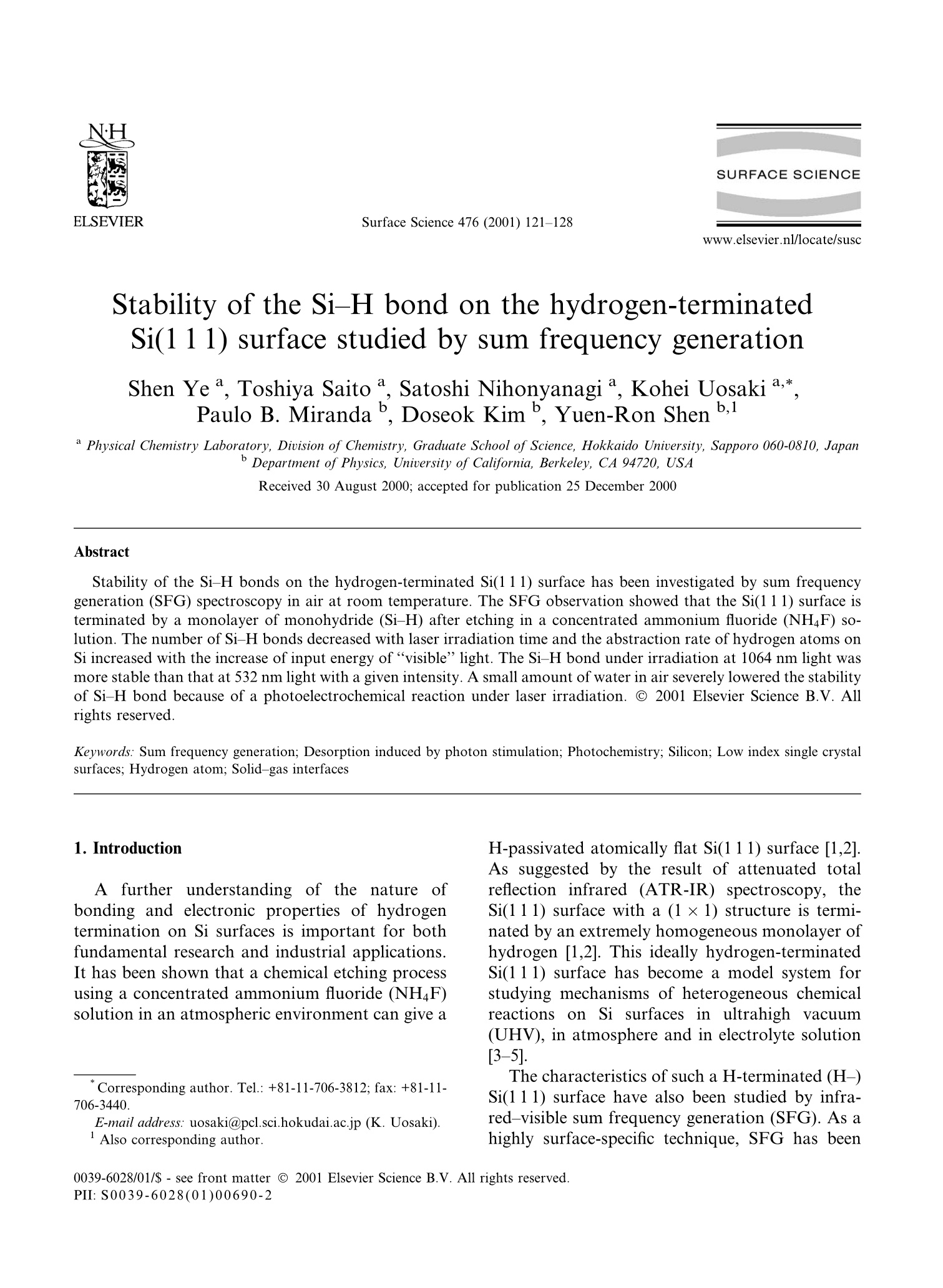
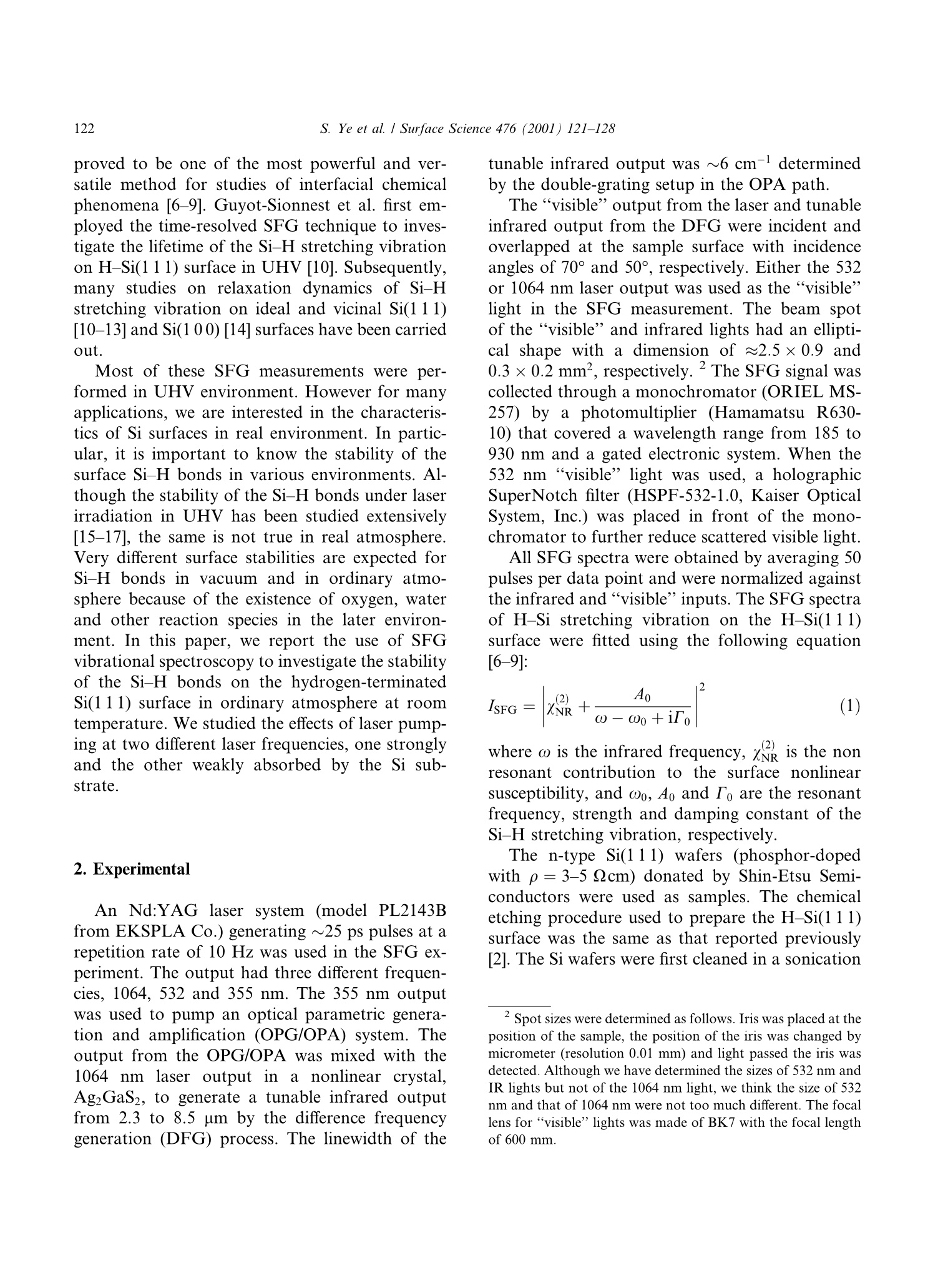

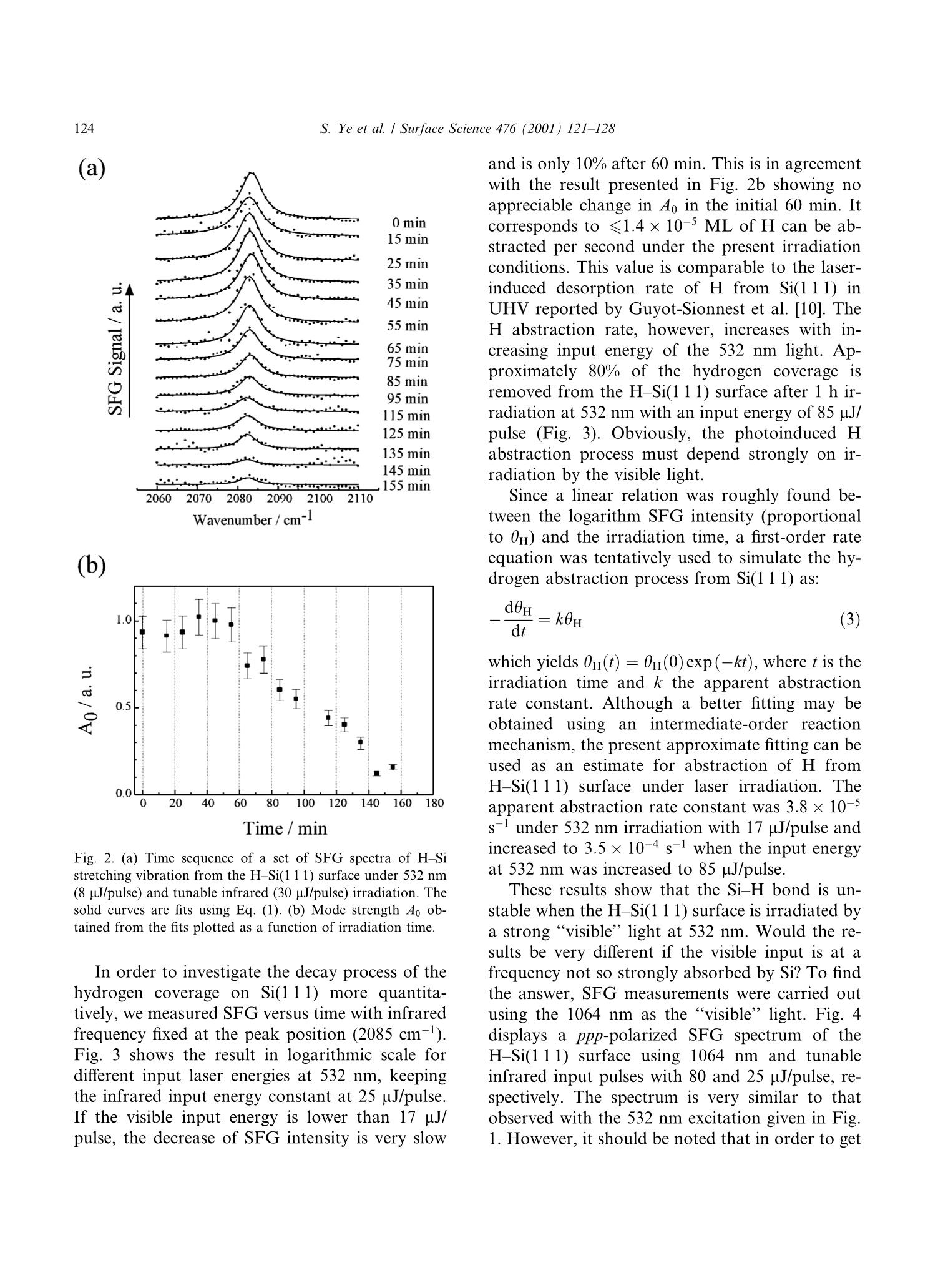


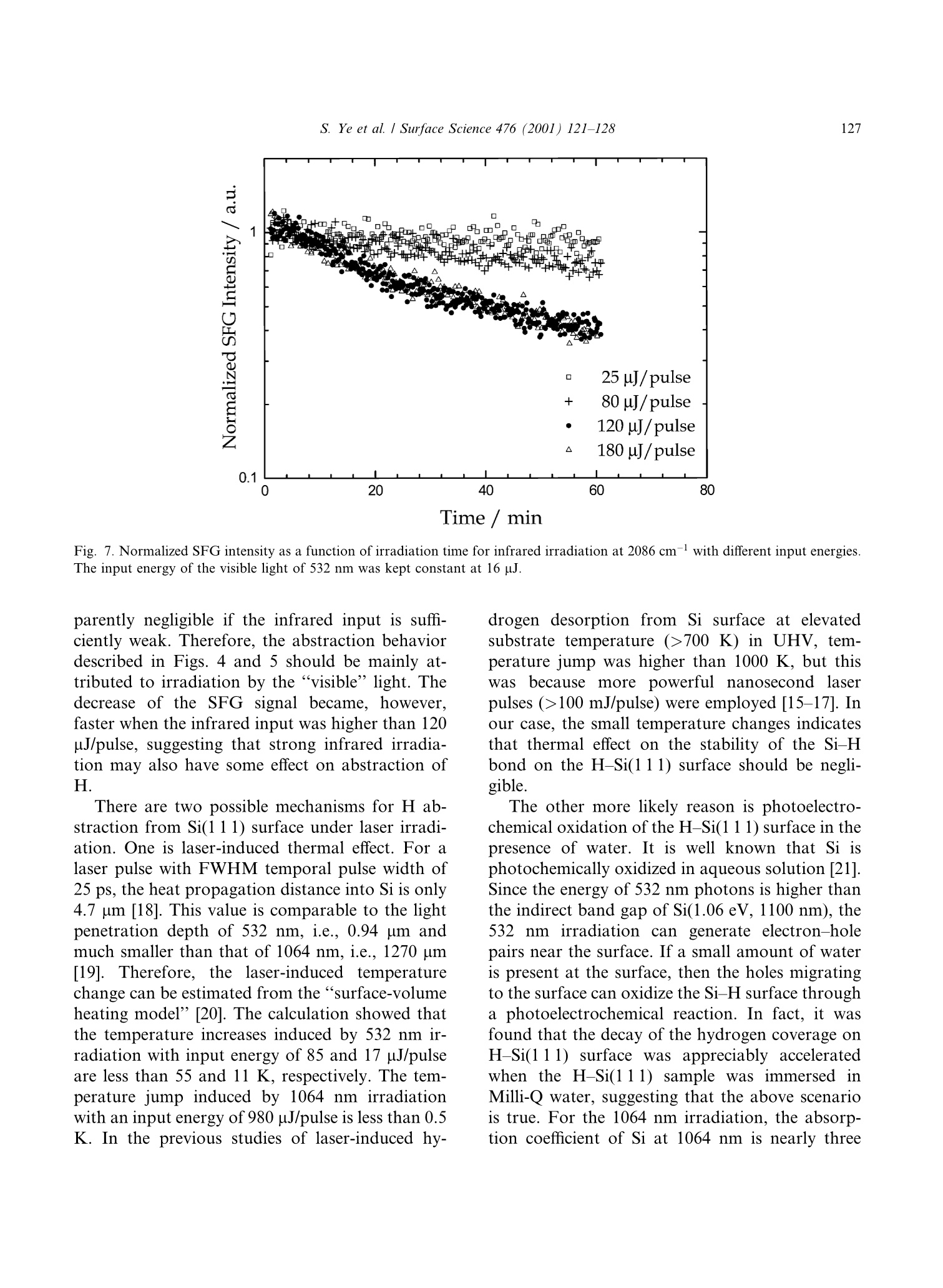
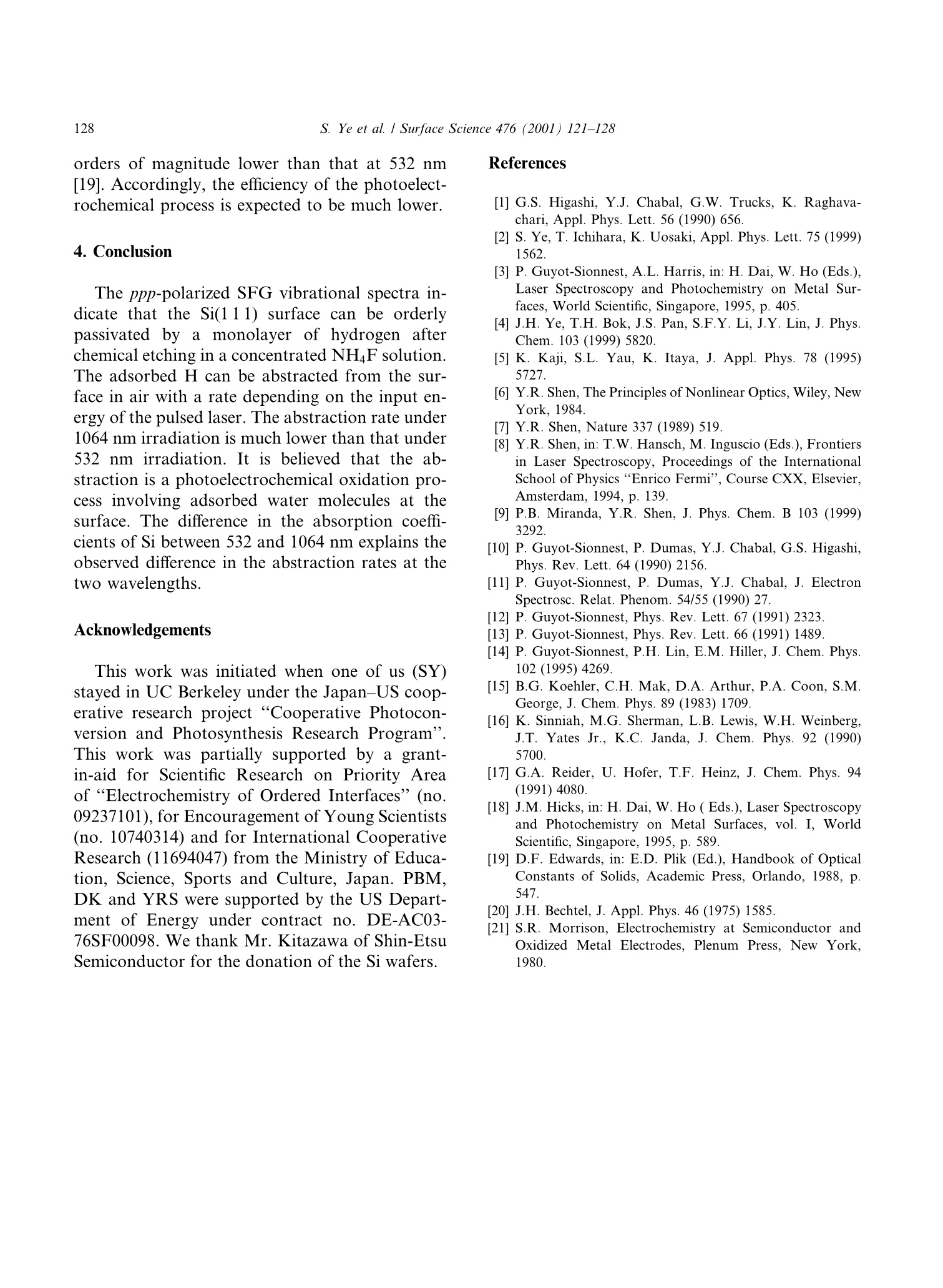
还剩6页未读,是否继续阅读?
北京欧兰科技发展有限公司为您提供《氢硅中表面Si-H键的稳定性检测方案(其它光谱仪)》,该方案主要用于其他中表面Si-H键的稳定性检测,参考标准--,《氢硅中表面Si-H键的稳定性检测方案(其它光谱仪)》用到的仪器有Ekspla SFG 表面和频光谱分析系统、Ekspla PL2230型高能量皮秒激光器
推荐专场
相关方案
更多
该厂商其他方案
更多

